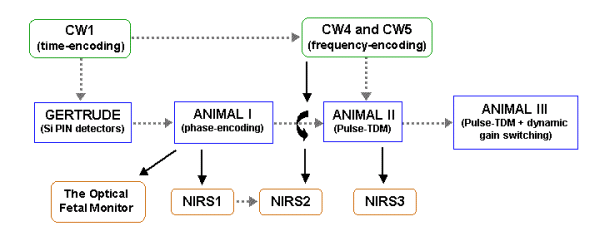
| Home | People | Publications | Research | Resources |
Animal I
Animal I was originally conceived of as a prototyping testbed for exploring the capabilities of two new multiplexing techniques, a phase-encoding technique called phase-division multiplexing and a time-encoding technique called pulse-TDM, which were being developed to eliminate the temporal skew problem inherent to the standard “switched-source” time-division multiplexing used in the CW1 imager. The results were promising. Phase-division multiplexing worked well for performing simultaneous dual-wavelength measurements. It allowed a doubling of throughput without increasing the channel bandwidth. When properly adjusted, the interchannel crosstalk was less than 0.1% (-60dB). Its main disadvantage was that only two sources could be used per modulation frequency in any one region of the head. Other disadvantages were a 6dB reduction in dynamic range and the need for stable phase alignment. For its initial application (single-point blood volume fraction and Hb/dHb ratio measurement), these disadvantages did not pose a problem. Only two sources were required for these initial measurements. Dynamic range was adjusted manually, with the gain controlled through resistor substitution. Phase alignment was easy to adjust and remained stable for months.
The phase-encoding technique validated by Animal I was later used in the design of the Optical Fetal Monitor, an instrument developed to monitor fetal blood oxygenation.

(return to the continuous-wave DOT instrument home page)